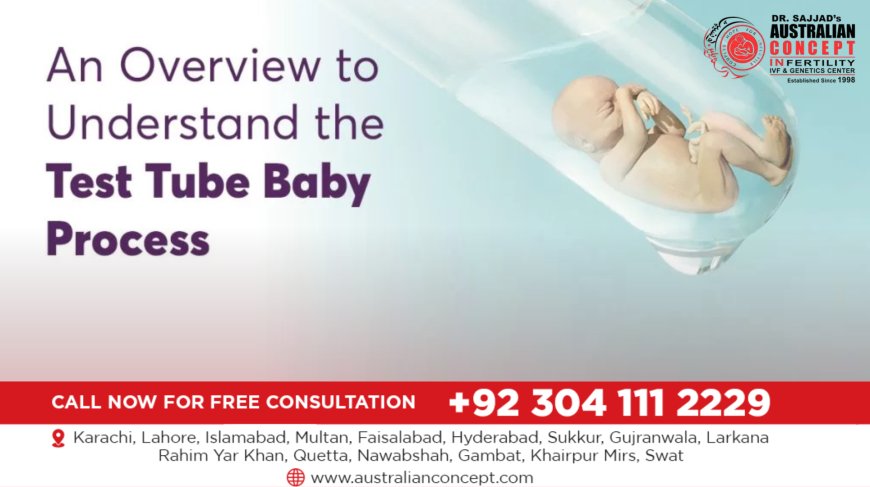What is the process of Test Tube Baby treatment in Lahore
Test Tube Baby treatment, also known as IVF, is a widely used fertility procedure in Lahore to help couples struggling with infertility. The process involves several key steps: initial consultation, ovarian stimulation, egg retrieval, sperm collection, fertilization in a lab, embryo transfer, and a final pregnancy test. This treatment is suitable for those with blocked tubes, male infertility, hormonal issues, or unexplained infertility. With advanced fertility care now available in Lahore, many couples are turning to this solution with hope and confidence for starting a family.

The dream of parenthood is natural for many couples, but when natural conception becomes difficult, medical science offers hope. One such remarkable advancement is Test Tube Baby treatment, also known as In Vitro Fertilization (IVF). In Lahore, many couples facing infertility turn to this method to start their families. Understanding the process can help ease anxiety and prepare you for the journey ahead.
What is a Test Tube Baby?
The term Test Tube Baby refers to a baby conceived through IVF. It doesnt mean the baby is grown in a test tube but rather that the egg is fertilized with sperm in a laboratory environment instead of the womans body. Once fertilization occurs, the embryo is transferred to the womans uterus, where it can grow naturally.
Who Needs Test Tube Baby Treatment?
Test Tube Baby treatment is usually recommended for couples who experience:
-
Blocked or damaged fallopian tubes
-
Male infertility issues (low sperm count or motility)
-
Endometriosis
-
Ovulation disorders
-
Unexplained infertility
-
Previous failed IUI or IVF attempts
Step-by-Step Process of Test Tube Baby Treatment in Lahore
Heres a breakdown of the entire Test Tube Baby treatment process:
1.Initial Consultation and Evaluation
The first step begins with a visit to a fertility specialist. Both partners undergo medical evaluations to assess their fertility status. This includes hormone tests, ultrasounds, semen analysis, and a review of medical history. Based on the findings, a customized treatment plan is prepared.
2.Ovarian Stimulation
To increase the chances of success, the woman is given hormone injections to stimulate her ovaries to produce multiple eggs instead of just one. This phase usually lasts 8 to 14 days and is closely monitored through blood tests and ultrasounds.
3.Egg Retrieval
Once the eggs have matured, a minor surgical procedure called egg retrieval is performed. Under sedation, a needle is guided through the vaginal wall to collect the eggs from the ovaries. This procedure is generally painless and takes about 20-30 minutes.
4.Sperm Collection
On the same day, the male partner provides a semen sample. If there are sperm-related issues, advanced techniques like ICSI (Intracytoplasmic Sperm Injection) may be used to inject a single sperm into each egg.
5.Fertilization and Embryo Development
The collected eggs and sperm are combined in the lab. Once fertilization occurs, the embryos are monitored for development over the next 3 to 5 days. The healthiest embryos are selected for transfer.
6.Embryo Transfer
The selected embryo is transferred into the womans uterus using a thin catheter. This is a painless, non-surgical procedure and takes only a few minutes. After the transfer, rest is recommended for a short period.
7.Post-Transfer Support and Medications
To support the embryo and help it implant, the woman may be prescribed progesterone or other hormone supplements. She will be monitored over the next two weeks.
8.Pregnancy Test
After about 14 days of embryo transfer, a blood test is performed to check for pregnancy. If successful, the treatment is followed by regular antenatal care. If not, the fertility specialist may discuss further steps, including repeating the IVF cycle or exploring other options.
What to Expect During the Process?
The journey of Test Tube Baby treatment can be emotionally and physically demanding. Some women experience mild side effects such as bloating, mood swings, or mild discomfort during egg retrieval. Support from loved ones, patience, and clear communication with your doctor are crucial throughout the process.
Success Rates in Lahore
Success rates for Test Tube Baby treatment in Lahore vary depending on factors like the womans age, the cause of infertility, and the fertility center's expertise. Younger women tend to have higher success rates. Many fertility clinic Lahore now offer world-class facilities and personalized treatment plans to increase the likelihood of success.
Final Thoughts
The Test Tube Baby process is a miracle of modern medicine, offering renewed hope to thousands of couples in Lahore each year. While it may require time, effort, and emotional resilience, the reward can be life-changing. Couples considering this option should consult experienced fertility experts, understand the procedure in depth, and prepare themselves emotionally and physically for the journey ahead.

































